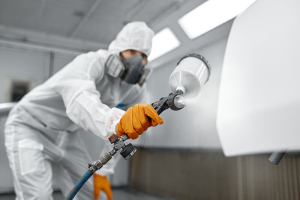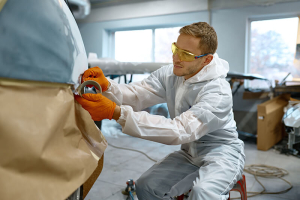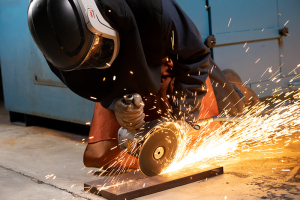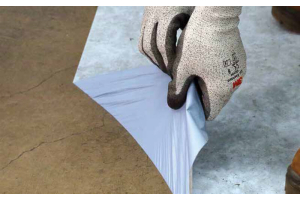6 Steps To Start A Respiratory Protection Program
6 Steps To Start A Respiratory Protection Program
Any successful workplace respiratory protection program needs to be compliant with the standards set by state and federal administrations like the Occupational Safety and Health Administration (OSHA) and understanding the nuances or different considerations for each standard is a challenging task. But those who do it well understand how to navigate the maze of regulations and hazards by using a written plan.
When respiratory protection is required by OSHA, a record of the guidelines for the program that includes everything from how to assess exposure to airborne contaminants, all the way down to regular fit testing and maintenance, to ensure continued safety for workers on-site. It's a complex process, but it's hardly something to be intimidated by. In fact, we can break it down to six key steps to help guide you as you adopt a more comprehensive respiratory safety plan.
Assessing exposure and keeping a record
OSHA requires employers to evaluate respiratory hazards on a regular basis to determine exposure levels, effective ways to control exposure, and which types of respirators can offer the protection your staff needs. While regular assessments are necessary, it's also helpful to re-evaluate your workplace anytime a change like new equipment or processes could result in a new exposure.
While some contaminants have specific standards that need specific supervision protocols, OSHA says that using a personal air monitoring device is the most reliable and accurate way to determine exposure. Industry studies, trade associations and manufacturer testing also provide guidance on how to handle specific materials.
OSHA measures contaminants in concentrations that are “immediately dangerous to life or health” (IDLH), and if an assessment shows that the airborne contaminants in a space are unacceptable, it's time to either change procedures, swap out materials, or limit exposure. If none of those are an option, it's up to you to provide the necessary respirators, training and medical evaluations to your employees.
Once you've identified the needs of your worksite, the next step is developing a written program. Keeping a written record is proof of compliance with OSHA regulations, while providing your employees with a resource about respiratory protection procedures. Your records should include all the policies and procedures for your workplace, list roles and responsibilities, and up-to-date documentation of all previous activity.
Choosing the Right Respirator for the Environment You Work In
After determining the hazards you're facing in the workplace, you'll be able to select a respirator that's approved by the National Institute for Occupational Safety and Health (NIOSH), as mandated by OSHA. Respirators can be selected by identifying the assigned protection factor (APF), which is the level of respiratory protection expected from a given class of respirators.
Different types of respirators, filters and cartridges are needed, depending on whether the airborne contaminants you're facing in the workplace are particles, gases, or other hazards, so choosing the right options is easier said than done. Respirators also need to be compatible with any of the personal protective equipment (PPE) your employees use.
The two major types of respirators are air-purifying respirators, and atmosphere-supplying respirators. Air-purifying respirators use filters, cartridges, or canisters to remove from the air before you breathe it in, while atmosphere-supplying respirators give you clean air from a dedicated source like an oxygen tank.
While a filtered facepiece respirator is the most common solution we see today, in industrial environments, full facemasks, or even a powered air-purifying respirator (PAPR), like the 3M™ Versaflow™ Heavy Industry PAPR Kit, offer superior performance.
Medical Evaluations and Fit Testing For Your Respirator
Not everyone is able to wear respiratory protection on the job due to various medical conditions, so it's critical to make sure an employee is medically cleared by a physician or licensed health care professional (PLHCP). OSHA requires workers to fill out forms to provide information on medical conditions and workplace hazards they face.
OSHA requires regular medical evaluations for employees, but a frequency of these examinations hasn't been defined. However, there are a few guidelines to steer you in the right direction. Things like changing workplace conditions, poor fit testing, or an employee presenting symptoms that impact their performance could all require re-evaluation. If nothing else, a PLHCP or manager may simply decide it's time to re-assess the status of their team.
Fit testing a respirator is critical to ensure there's a proper seal in the mask, as well as finding something that's comfortable for an employee to wear. There are two types of fit test, including a qualitative fit test (QLFT), which uses an individual employee's senses to see if they notice scents from harmless OSHA-accepted test agents like isoamyl acetate, saccharin, or an irritant smoke. Alternatively, you can perform exhaustive quantitative fit testing (QNFT) to identify and measure leakage around a face seal.
Training Employees for Correct Respirator Usage and Maintenance
Annual training is mandated by OSHA and is required to explain why a respirator is needed, while highlighting what a respirator can and can't do to protect an employee. This training is a great way to show your workforce how to correctly use a respirator, performing a seal check, or even how to use a respirator in emergencies.
Respirators should be stored in a safe environment to protect them from damage and contamination and inspected before each use. And each mask should be cleaned and disinfected, although frequency depends on the usage – for respirators used exclusively by one employee, cleaning enough to keep it sanitized is good enough, while shared respirators should be disinfected before every use.
Ready To Learn More?
For additional tips on how to keep your respirator in tip-top shape, please read "Troubleshooting Tips to Keep Your Respirator Working."
30-Second Summary:
- ✔ Assessing your exposure to contaminants will help you determine which respirator is ideal for your work environment.
- ✔ Evaluating an employee's health will identify medical conditions that may prohibit wearing a respirator.
- ✔ Fit testing a respirator and providing the correct training on usage will help employees maximize effectiveness.
- ✔ Regular maintenance, storage, and replacement of respirators will help keep your workforce safe from hazards.
- ✔ Keep a written record of all of the above to help solve emerging issues before they become larger problems.










